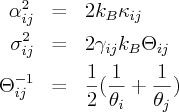pair_style dpd/fdt command
pair_style dpd/fdt/energy command
Syntax
pair_style style args
- style = dpd/fdt or dpd/fdt/energy
- args = list of arguments for a particular style
dpd/fdt args = T cutoff seed T = temperature (temperature units) cutoff = global cutoff for DPD interactions (distance units) seed = random # seed (positive integer) dpd/fdt/energy args = cutoff seed cutoff = global cutoff for DPD interactions (distance units) seed = random # seed (positive integer)
Examples
pair_style dpd/fdt 300.0 2.5 34387 pair_coeff * * 3.0 1.0 2.5 pair_style dpd/fdt/energy 2.5 34387 pair_coeff * * 3.0 1.0 0.1 2.5
Description
Styles dpd/fdt and dpd/fdt/energy compute the force for dissipative particle dynamics (DPD) simulations. The dpd/fdt style is used to perform DPD simulations under isothermal and isobaric conditions, while the dpd/fdt/energy style is used to perform DPD simulations under isoenergetic and isoenthalpic conditions (see (Lisal)). For DPD simulations in general, the force on atom I due to atom J is given as a sum of 3 terms

where Fc is a conservative force, Fd is a dissipative force, and Fr is a random force. Rij is a unit vector in the direction Ri - Rj, Vij is the vector difference in velocities of the two atoms = Vi - Vj, alpha is a Gaussian random number with zero mean and unit variance, dt is the timestep size, and w(r) is a weighting factor that varies between 0 and 1. Rc is the cutoff. The weighting factor, omega_ij, varies between 0 and 1, and is chosen to have the following functional form:

Note that alternative definitions of the weighting function exist, but would have to be implemented as a separate pair style command.
For style dpd/fdt, the fluctuation-dissipation theorem defines gamma to be set equal to sigma*sigma/(2 T), where T is the set point temperature specified as a pair style parameter in the above examples. The following coefficients must be defined for each pair of atoms types via the pair_coeff command as in the examples above, or in the data file or restart files read by the read_data or read_restart commands:
- A (force units)
- sigma (force*time^(1/2) units)
- cutoff (distance units)
The last coefficient is optional. If not specified, the global DPD cutoff is used.
Style dpd/fdt/energy is used to perform DPD simulations under isoenergetic and isoenthalpic conditions. The fluctuation-dissipation theorem defines gamma to be set equal to sigma*sigma/(2 dpdTheta), where dpdTheta is the average internal temperature for the pair. The particle internal temperature is related to the particle internal energy through a mesoparticle equation of state (see fix eos). The differential internal conductive and mechanical energies are computed within style dpd/fdt/energy as:

where

Zeta_ij^q is a second Gaussian random number with zero mean and unit variance that is used to compute the internal conductive energy. The fluctuation-dissipation theorem defines alpha*alpha to be set equal to 2*kB*kappa, where kappa is the mesoparticle thermal conductivity parameter. The following coefficients must be defined for each pair of atoms types via the pair_coeff command as in the examples above, or in the data file or restart files read by the read_data or read_restart commands:
- A (force units)
- sigma (force*time^(1/2) units)
- kappa (energy*temperature/time units)
- cutoff (distance units)
The last coefficient is optional. If not specified, the global DPD cutoff is used.
The pairwise energy associated with styles dpd/fdt and dpd/fdt/energy is only due to the conservative force term Fc, and is shifted to be zero at the cutoff distance Rc. The pairwise virial is calculated using only the conservative term.
The forces computed through the dpd/fdt and dpd/fdt/energy styles can be integrated with the velocity-Verlet integration scheme or the Shardlow splitting integration scheme described by (Lisal). In the cases when these pair styles are combined with the fix shardlow, these pair styles differ from the other dpd styles in that the dissipative and random forces are split from the force calculation and are not computed within the pair style. Thus, only the conservative force is computed by the pair style, while the stochastic integration of the dissipative and random forces are handled through the Shardlow splitting algorithm approach. The Shardlow splitting algorithm is advantageous, especially when performing DPD under isoenergetic conditions, as it allows significantly larger timesteps to be taken.
Restrictions
These commands are part of the USER-DPD package. They are only enabled if LAMMPS was built with that package. See the Making LAMMPS section for more info.
Pair styles dpd/fdt and dpd/fdt/energy require use of the comm_modify vel yes option so that velocites are stored by ghost atoms.
Pair style dpd/fdt/energy requires atom_style dpd to be used in order to properly account for the particle internal energies and temperatures.